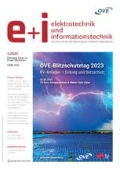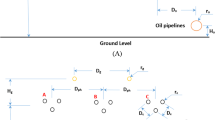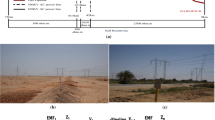Summary
Inductive interference of natural gas-, oil-, district heating- and water-pipelines due to short circuit and operation currents of high voltage lines and electric railways is a noticed problem since influencing and influenced systems are constructed very close together in the same so called "energy route". The measurement of the pipe potentials against remote earth at defined pipeline locations as well as the calculation of the induced voltage along an interfered pipeline is very important to identify critical sections on the pipeline to reduce the risk of hazard on the one hand and the a.c. corrosion possibility on the other hand. A.c. corrosion, which already begins at induced voltages in the range of 4–10 V depending on the specific soil resistivity can lead to pipeline leakages in worst case. This paper delivers some insights into an actual interfering situation regarding a new built 400 kV overhead line and an existing natural gas pipeline. The methods of measuring and simulation are described separately. Afterwards the results are compared and discussed. Finally, common potential mitigating measures such as a.c. earthing systems and galvanic separations by insulating joints in the course of the pipeline, as well as some alternative measures like the connection to low impedant operational earths of in Austria applied low voltage TN-systems and the use of surge arrestors, are shown.
Similar content being viewed by others
References
AfK-Empfehlung Nr. 3 (2006): Maßnahmen beim Bau und Betrieb von Rohrleitungen im Einflussbereich von Hochspannungs-Drehstromanlagen und Wechselstrom-Bahnanlagen. Working group DVGW/VDE for corrosion (AfK), October 2006
Braunstein, R. (2011): Technical and economical optimisation of measures decreasing inductive interference of metallic pipelines. Dissertation, Institute of Electrical Power Systems, Graz University of Technology, work in progress
Carson, J. (1926): Wave propagation in overhead wires with ground return. Bell System Technical Journal, 5 (1926): 539–554
CEN/TS 15280 (2006): Evaluation of a.c. corrosion likelihood of buried pipelines – application to the cathodically protected pipelines. CEN, March 2006
Michailow, M., Rasumov, Z. D. (1963): Electrical parameters of metallic pipelines in earth. Èlektričestvo, Journal, 5 (1963): 60–63
NullVO BGBl. 1998 Teil 2, 322. VO: Verordnung des Bundesministers für wirtschaftliche Angelegenheiten über die Anforderungen an öffentliche Verteilnetze mit der Nennspannung 400/230 V und an diese angeschlossenen Verbraucheranlagen zur grundsätzlichen Anwendung der Schutzmaßnahme Nullung. Austrian Federal Law Gazette, September 1998
Pollaczek, F. (1927): Über die Induktionswirkung einer Wechselstromeinfachleitung. Elektrische Nachrichtentechnik, Journal, 4 (1927)
Schmautzer, E. (1990): Ein Beitrag zur Berechnung der niederfrequenten induktiven Beeinflussung von Rohrleitungsnetzen. Dissertation, Institute of Electrical Power Systems, Graz University of Technology
Schmautzer, E., Braunstein, R. (2009): Lösungsansätze zur Reduktion der Wechselstromwahrscheinlichkeit von induktiv beeinflussten Rohrleitungen durch Traktionsströme elektrischer Bahnanlagen. e&i, H. 6: 221–226
Schmautzer, E., Linhardt, P., Friedl, W., Ball, G. (2004): Wechselstromkorrosion an Rohrleitungen – Modellbildung und elektrochemische Analyse. Study by order of the Österreichische Vereinigung für das Gas- und Wasserfach (ÖVGW)
TE 30 (1987): Technical recommendation Nr. 30: Maßnahmen beim Bau und Betrieb von Rohrleitungen im Einflussbereich von Starkstromanlagen mit Nennspannungen über 1 kV. Technical committee for interference (OVE), April 1987
Author information
Authors and Affiliations
Rights and permissions
About this article
Cite this article
Fickert, L., Schmautzer, E., Braunstein, R. et al. Reduction of the electrical potential of interfered pipelines due to currents of high voltage power lines and electric railways. Elektrotech. Inftech. 127, 362–366 (2010). https://doi.org/10.1007/s00502-010-0793-3
Published:
Issue Date:
DOI: https://doi.org/10.1007/s00502-010-0793-3




